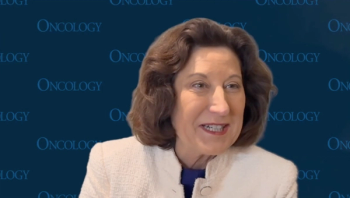
Oncology NEWS International
- Oncology NEWS International Vol 13 No 4
- Volume 13
- Issue 4
Tam Not Linked to High-Risk Endometrial Ca
SAN DIEGO-In a cohort of endometrial cancer patients at M.D. Anderson Cancer Center, those who had previously developed breast cancer and used tamoxifen did not have a higher incidence of high-risk histologic subtypes, compared with breast cancer patients not receiving tamoxifen, reported Brian M. Slomovitz, MD, at the Society of Gynecologic Oncologists 35th Annual Meeting (SGO abstract 24).
SAN DIEGOIn a cohort of endometrial cancer patients at M.D. Anderson Cancer Center, those who had previously developed breast cancer and used tamoxifen did not have a higher incidence of high-risk histologic subtypes, compared with breast cancer patients not receiving tamoxifen, reported Brian M. Slomovitz, MD, at the Society of Gynecologic Oncologists 35th Annual Meeting (SGO abstract 24).
It is well known that tamoxifen reduces the incidence of breast cancer by 50%, but it imposes a two- to sixfold increased risk of developing endometrial cancer, according to a number of studies. Whether cancers associated with tamoxifen are more aggressive is unclear, since the study results have been contradictory on this issue.
"As gynecologic oncologists, we need to know if a history of tamoxifen use affects the clinical course of endometrial cancer in patients with a history of breast cancer," Dr. Slomovitz said.
The study was a retrospective chart review of 1,307 patients with endometrial carcinoma seen at M.D. Anderson between 1990 and 2002. The study identified 77 patients with breast cancer for whom clinical and pathologic information was obtained.
Forty of 77 breast cancer patients (52%) had a history of tamoxifen use; median duration of use was 48 months (range, 6 to 120 months). The median age at diagnosis of endometrial cancer was 65, and was 59 at the time of breast cancer diagnosis. A family history of breast cancer was noted for 29% of patients. There were no significant differences in clinical features between tamoxifen users and nonusers, and the most common presenting symptom was abnormal vaginal bleeding.
Endometrioid Type Prevails
More than two thirds of patients stopped taking tamoxifen within 2 months of their endometrial cancer diagnosis. Patients in whom endometrial cancer developed while taking tamoxifen were more likely to have endometrioid type endometrial cancers than women who stopped the drug for other reasons, Dr. Slomovitz reported, suggesting that tamoxifen appears to play a greater role in these, rather than high-risk, subtypes.
Forty-eight women developed endometrioid endometrial cancer and 29 developed high-risk histologic subtypesserous, clear cell, or malignant mixed Mullerian tumor (MMMT). A high-risk histologic subtype was diagnosed in 43% of the tamoxifen users, compared with 32% of the nonusers, which was not a statistically significant difference. In addition, there were no significant differences in stage or grade of cancer between tamoxifen users and nonusers, he said.
Shorter Time to Diagnosis
Interestingly, compared with women who did not take tamoxifen, women who took tamoxifen had a significantly shorter time to the diagnosis of endometrial cancer: 78 months for users vs 115 months for nonusers. In the subgroup of patients who developed endometrioid cancers, tamoxifen use was again associated with a decreased interval from time of breast cancer to the diagnosis of endometrial cancer: 67 months for users vs 129 months for nonusers. This difference was not seen among the women who developed high-risk histological subtypes.
There was no difference in the recurrence rate of endometrial cancer between tamoxifen users and nonusers. Patients with aggressive histologic subtypes were more likely to recur, regardless of tamoxifen use, he reported.
The risk of dying from endometrial cancer did not appear to be enhanced by tamoxifen use. While tamoxifen users had a 5-year survival rate of 18% (after diagnosis of endometrial cancer), compared with 44% for nonusers, they had a disease-specific survival of 47%, compared with 57%, which was not significantly different. There were no differences in overall survival or disease-specific survival in patients with uterine papillary serous carcinoma or clear cell cancers, based on tamoxifen use.
"Previous tamoxifen use was associated with a decreased interval to development of endometrial cancer. This association was highlighted in the subgroup of women with endometrioid tumors," Dr. Slomovitz summarized.
The researchers did not detect a difference in endometrial-cancer-specific survival based on a history of tamoxifen use. "Although the reasons for the difference in overall survival are not clear, it may be because endometrial cancer often affects older women with comorbidities and because this disease is often associated with a favorable outcome. Most women with endometrial cancer do not die from this disease," he said.
Discussant
Richard Barakat, MD, of Memorial Sloan-Kettering Cancer Center, in his discussion of the paper, said, "The issue of tamoxifen-associated endometrial cancer remains important. Clearly, with approximately 80,000 women going on tamoxifen each year, and new indications for tamoxifen as a prophylactic agent, we really do need to get a handle on the risks for the various types of endometrial cancers that develop in these women. This study adds to the growing body of literature in this area."
Dr. Barakat cautioned that the study is retrospective, with a small number of breast cancer patients, and also excluded sarcomas, which may be an important issue since several studies have shown a small increased relative risk of sarcoma with tamoxifen. "I question whether it is really the use of tamoxifen that causes these types of cancers to occur. It may have something to do with the genetics of having both breast and endometrial cancer," he said.
Articles in this issue
over 21 years ago
Anastrozole Advantage Greatest in ER+/PR- Pts: ATACover 21 years ago
No Detriments From Lumpectomy/RT in BRCA 1/2 Carriersover 21 years ago
Second-Line Imatinib Produces CCRs in CML PatientsNewsletter
Stay up to date on recent advances in the multidisciplinary approach to cancer.















































































